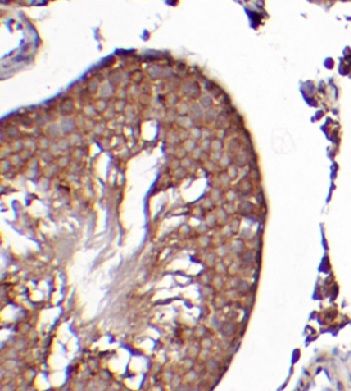Description
| Product Name | anti- GPX4 antibody |
| Catalogue No. | 02601AB |
| Size | 100µg |
| Form | liquid |
| Purification | Protein A+G purification |
| Purity | ≥95% as determined by SDS-PAGE |
| Host | Mouse |
| Clonality | monoclonal |
| Isotype | IgG2b |
| Storage | PBS with 0.02% sodium azide and 50% glycerol pH 7.3 , -20℃ for 12 months (Avoid repeated freeze / thaw cycles.) |
BACKGROUND
The protein encoded by this gene belongs to the glutathione peroxidase family, members of which catalyze the reduction of hydrogen peroxide, organic hydroperoxides and lipid hydroperoxides, and thereby protect cells against oxidative damage. Several isozymes of this gene family exist in vertebrates, which vary in cellular location and substrate specificity. This isozyme has a high preference for lipid hydroperoxides and protects cells against membrane lipid peroxidation and cell death. It is also required for normal sperm development; thus, it has been identified as a ‘moonlighting’ protein because of its ability to serve dual functions as a peroxidase, as well as a structural protein in mature spermatozoa. Mutations in this gene are associated with Sedaghatian type of spondylometaphyseal dysplasia (SMDS). This isozyme is also a selenoprotein, containing the rare amino acid selenocysteine (Sec) at its active site. Sec is encoded by the UGA codon, which normally signals translation termination. The 3′ UTRs of selenoprotein mRNAs contain a conserved stem-loop structure, designated the Sec insertion sequence (SECIS) element, that is necessary for the recognition of UGA as a Sec codon, rather than as a stop signal. Alternatively spliced transcript variants have been found for this gene.
IMMUNOGEN INFORMATION
| Immunogen | glutathione peroxidase 4 (phospholipid hydroperoxidase) |
| Observed MW | 22 kDa |
APPLICATION
| Tested Application | ELISA, WB, IHC, IF |
| Recommended Dilution | WB: 1:500-1:2000; IHC: 1:500-1:2000; IF: 1:100-1:500 |
IMAGES
| Immunohistochemistry of paraffin-embedded rat testis using (GPX4 antibody) at dilution of 1:1000 |  |
| Various lysates were subjected to SDS PAGE followed by western blot with (GPX4 antibody) at dilution of 1:1000 |  |


Reviews
There are no reviews yet.